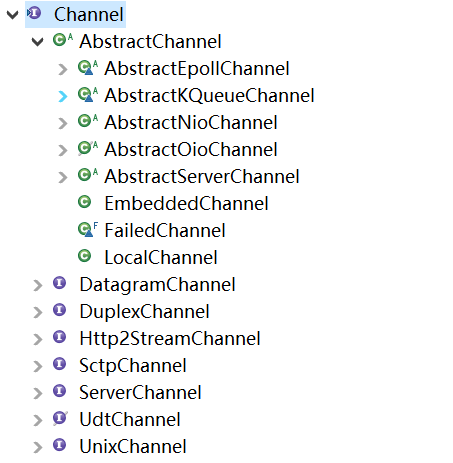Channel是Netty网络通信的主体,由它负责同对端进行网络通信、注册和数据操作等功能。
AbstractChannel是Channel的一个抽象类。
1) 通道状态主要包括:打开、关闭、连接
2) 通道主要的IO操作,读(read)、写(write)、连接(connect)、绑定(bind)。
3) 所有的IO操作都是异步的,调用诸如read,write方法后,并不保证IO操作完成,但会返回一个凭证,在IO操作成功,取消或失败后会记录在该凭证中。
4) channel有父子关系,SocketChannel是通过ServerSocketChannel接受创建的,故SocketChannel的parent()方法返回的就是ServerSocketChannel。
5) 在Channel使用完毕后,请调用close方法,释放通道占用的资源。
//返回全局唯一的channel id ChannelId id(); //返回该Channel注册的线程模型,先理解为Ractor模型的Ractor线程。 EventLoop eventLoop(); //返回该Channel由谁创建的,ServerSocketChannel返回null,SocketChannel返回创建它的ServerSocketChannel Channel parent(); //返回通道的配置信息 ChannelConfig config(); //通道是否打开 boolean isOpen(); //该通道是否已经注册在事件模型中,此处先参考Nio编程模型,一个通过需要注册在Register上 boolean isRegistered(); //通道是否激活 boolean isActive(); //通道是否支持 调用disconnect方法后,调用connect方法 ChannelMetadata metadata(); //返回绑定的地址,服务端的Channel返回监听的地址,而客户端的Channel返回连接到服务端的本地套接字。 SocketAddress localAddress(); //返回channel的远程套接字。 SocketAddress remoteAddress(); //通道的关闭凭证(许可),这里是多线程编程一种典型的设计模式,一个channle返回一个固定的 ChannelFuture closeFuture(); //是否可写,如果通道的写缓冲区未满,即返回true,表示写操作可以立即操作缓冲区,然后返回。 boolean isWritable(); Unsafe unsafe(); //返回管道 ChannelPipeline pipeline(); //返回ByteBuf内存分配器 ByteBufAllocator alloc(); //诸如newPromise,newSuccessedFuture()方法,就是返回一个凭证,用来保存通知结果的 ChannelPromise newPromise(); ChannelProgressivePromise newProgressivePromise(); ChannelFuture newSucceededFuture(); ChannelFuture newFailedFuture(Throwable cause); ChannelPromise voidPromise(); //绑定 ChannelFuture bind(SocketAddress localAddress); //连接 ChannelFuture connect(SocketAddress remoteAddress); ChannelFuture connect(SocketAddress remoteAddress, SocketAddress localAddress); //断开连接 ChannelFuture disconnect(); //关闭,释放通道资源 ChannelFuture close(); ChannelFuture deregister(); ChannelFuture bind(SocketAddress localAddress, ChannelPromise promise); ChannelFuture connect(SocketAddress remoteAddress, ChannelPromise promise); ChannelFuture connect(SocketAddress remoteAddress, SocketAddress localAddress, ChannelPromise promise); ChannelFuture disconnect(ChannelPromise promise); ChannelFuture close(ChannelPromise promise); ChannelFuture deregister(ChannelPromise promise); Channel read(); ChannelFuture write(Object msg); ChannelFuture write(Object msg, ChannelPromise promise); Channel flush(); ChannelFuture writeAndFlush(Object msg, ChannelPromise promise); ChannelFuture writeAndFlush(Object msg); interface Unsafe { RecvByteBufAllocator.Handle recvBufAllocHandle(); ChannelHandlerInvoker invoker(); SocketAddress localAddress(); SocketAddress remoteAddress(); void register(EventLoop eventLoop, ChannelPromise promise); void bind(SocketAddress localAddress, ChannelPromise promise); void connect(SocketAddress remoteAddress, SocketAddress localAddress, ChannelPromise promise); void disconnect(ChannelPromise promise); void close(ChannelPromise promise); void closeForcibly(); void deregister(ChannelPromise promise); void beginRead(); void write(Object msg, ChannelPromise promise); void flush(); ChannelPromise voidPromise(); //返回通道的环形缓存区 ChannelOutboundBuffer outboundBuffer(); }
Channel类图:
